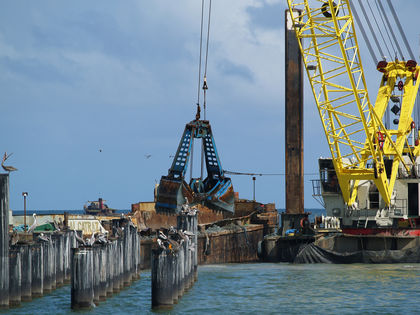Trinidad and Tobago - Economy

Trinidad and Tobago is a twin island state whose economy is oriented toward trade and tourism. The economy of the larger island, Trinidad, is more heavily industrialized, dominated by the oil and gas sector, although agriculture, tourism, manufacturing and construction also make significant contributions. Tobago is dominated by tourism and agriculture. The country cannot feed itself and must look abroad not only for its food staple, but also for the bulk of manufactured goods. Import payments are met by the export of petroleum and products, invisible exports, tourism, and the transshipment trade. Specialized tropical crops are produced for export, but exploitation of petroleum reserves and refining of local and imported oils and their subsequent export are the dominant factors of the country's economy. Although by far the most prosperous of Caribbean nations, the country's high degree of dependence on oil revenues has made it exceedingly vulnerable to falling oil prices. Over the past three decades, its economic fortunes have followed closely the world price of oil, its major export commodity. Oil revenue windfall after 1973 brought unprecedented prosperity. However, this prosperity was not sustained when oil prices began to fall in 1982. Only after a further steep decline in the price of oil in 1986 did the government face the challenge of a fundamental adjustment in economic policy and initiate a program supported by the World Bank and the IMF. The country began the difficult transition from an oil dependent, public sector dominated economy, to a more diversified, market-oriented, private sector-led one.
After a decade of almost uninterrupted economic decline, growth returned in 1995, when real GDP increased 2.4%. Growth accelerated from 3-5% in the middle of the decade to an average of 5.17% by 1998 to 2000. The economy's performance is attributable to energy-related investments, growth in the non-energy sector (increased manufactured exports, increased domestic demand for construction and services, and development of off-shore financial services), and sound macroeconomic policies. The government's stabilization policies yielded results in a fall in the annual inflation rate from double digits—13.3% in 1993—to a range of between 3.5% and 5.6% by 1996 to 2002. A surge in imports related to a boom in the hydrocarbons sector helped raise the current account deficit to an average equal to 10.25% of GDP in 1997 and 1998, but by 2000, this had been transformed into a current account surplus equal to almost 5% of GDP.
The global slowdown in 2001 and the world-wide declines in tourism and foreign investment after the 11 September 2001 terrorist attacks in the United States did not seriously impact economic growth in Trinidad and Tobago, though the real GDP growth rate declined from 4.8% in 2000 to 4% in 2001. Inflation was at 5.5%. Unemployment, at 11.8%, remained a problem. The industrial sector of the economy, dominated by the capital-intensive petroleum industry, accounts for over 43% of the GDP but employs only 14% of the labor force. For 2002, growth was estimated to have declined to 3.8%, as the post-11 September effects on tourism and investment made more of an economic impact. Inflation was estimated at 5.2%.
I would love for you to help me with this question. Evaluate Trinidad and Tobago economic conditions that you think would influence the success or other wise of a value added type of tax.